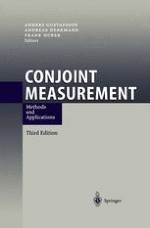
2003 | OriginalPaper | Chapter
Conjoint Analysis as an Instrument of Market Research Practice
Authors : Anders Gustafsson, Andreas Herrmann, Frank Huber
Published in: Conjoint Measurement
Publisher: Springer Berlin Heidelberg
Included in: Professional Book Archive
Activate our intelligent search to find suitable subject content or patents.
Select sections of text to find matching patents with Artificial Intelligence. powered by
Select sections of text to find additional relevant content using AI-assisted search. powered by
The essay by the psychologist, Luce, and the statistician, Tukey (1964) can be viewed as the origin of conjoint analysis (Green and Srinivasan 1978; Carroll and Green 1995). Since its introduction into marketing literature by Green and Rao (1971) as well as by Johnson (1974) in the beginning of the 1970s, conjoint analysis has developed into a method of preference studies that receives much attention from both theoreticians and those who carry out field studies. For example, Cattin and Wittink (1982) report 698 conjoint projects that were carried out by 17 companies included in their survey in the period from 1971 to 1980. For the period from 1981 to 1985, Wittink and Cattin (1989) found 66 companies in the United States that were in charge of a total of 1062 conjoint projects. As regards Europe, Wittink, Vriens and Burhenne counted a total of 956 projects carried out by 59 companies in the period from 1986 to 1991 (Wittink, Vriens and Burhenne 1994 and Baier and Gaul 1999). A survey initiated in Germany in 1998 in which a total of 519 companies and chairs at universities of the country were to provide information on their activities in the field of conjoint analysis for the period from 1993 to 1998 shows that 52 institutions interested in the study design an average of 6 conjoint analyses per year (Melles and Holling 1999; for an earlier study Schubert 1991). If we project the number of analyses for the total period of five years, we get approx. 1531 projects.